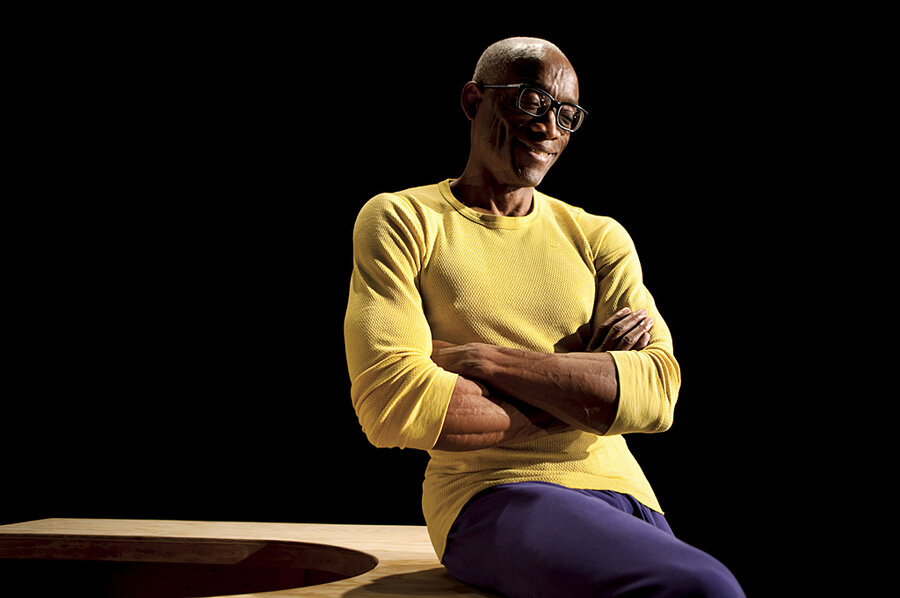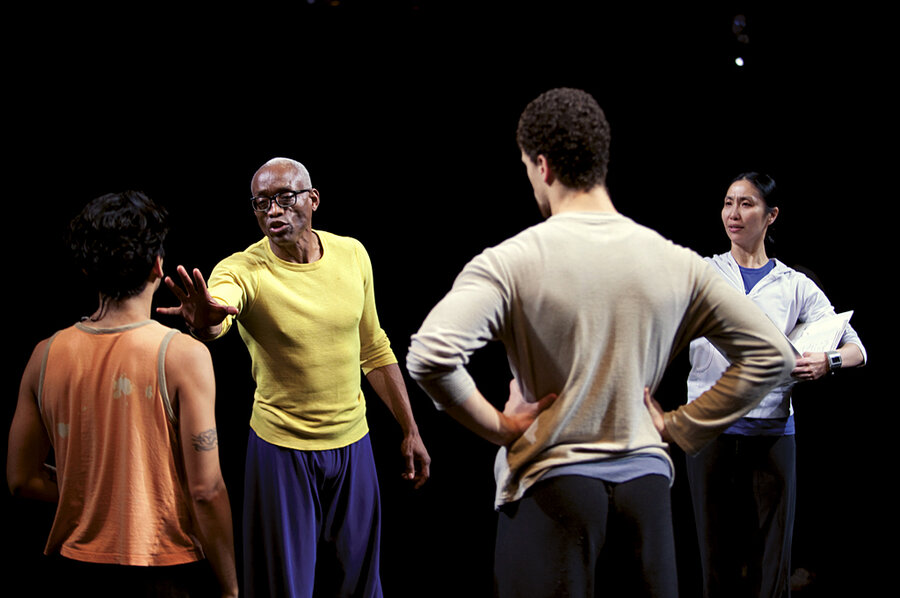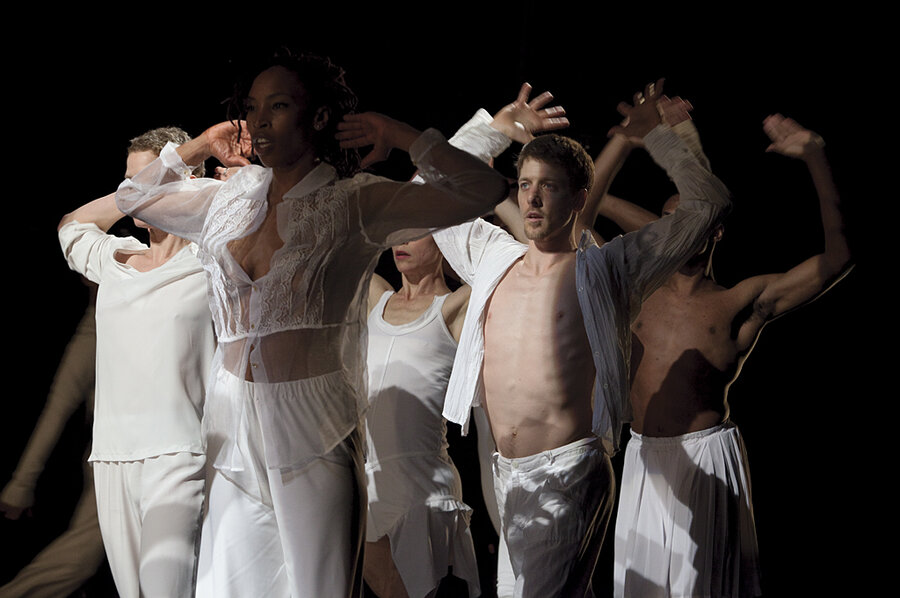Profile: Bill T. Jones, a master of modern dance
Loading...
Two men are dancing on stage, the small, tightly coiled white man darting around the 6-foot-1 black man who projects an elegant, riveting charisma. The year is 1981; they have been performing together for eight years. However it is still new that they are partnering each other in ways that men usually treat women – lifting each other, trading tender looks. Although there are established black companies in America by now, seldom are black dancers and white dancers seen side by side.
Bill T. Jones, the tall man, and Arnie Zane, his partner, talk out loud as they move, pushing another boundary. Zane recites a speech in Dutch, learned when he spent a period in Amsterdam. Jones recites the names of his 11 brothers and sisters.
Now, 30 years later, Jones is still speaking his mind, only this time as a trailblazer at the confluence of the avant-garde and commercial theater. You cannot miss his presence: His company will be performing in Arizona, California, North Carolina, Virginia, and New York this spring, while "FELA!" – his Broadway musical – starts its world tour in Lagos, Nigeria, in April and continues in London in the summer.
Born William Tass Jones in Florida to migrant workers, his family moved north when he was 3. Jones reaches back often to memories of family, race, and his mother's sustaining religious beliefs as he choreographs his works. Zane died in 1988 from complications of AIDS, but the company they formed in 1982 continues to bear his name.
Last year, Jones stood in the spotlight at the Kennedy Center in Washington, D.C., to receive the nation's honors, along with Oprah Winfrey, Sir Paul McCartney, and others. Jones was recognized for his accomplishments as a striking performer and creator in the uniquely American art forms of modern dance and musical theater, not to mention the fearless reflection of political concerns in his work.
The clarity of his outspokenness barely masks the fact that he cares very deeply about his family, his friends and associates, and his country. "When I dance, as when I talk, I strive for candor," Jones says.
The Kennedy Center Honors capped his annus mirabilis, a year of marvels: three more Tony Awards for the Afro-beat Broadway musical "FELA!" which he choreographed and directed, to add to his 2007 Tony for "Spring Awakening." In January, "FELA!" was broadcast live to 375 screens in 21 countries from the stage of London's National Theatre.
But Jones has not stopped wanting more. Returning early last month to the world of contemporary dance, he staged three works from those early years of the Bill T. Jones/Arnie Zane Dance Company. "Body Against Body," a revival of pieces he created and performed with Zane, premièred last month at Boston's Institute of Contemporary Art. Jones cast a man and a woman, rather than two men, in one of the duets.
"Arnie's no longer here. I'm not the same person. These works must now be seen for their ideas," Jones remarks, speaking by telephone for two interviews, and in person during the Boston weekend.
The idea of a dance studio was new to Jones when he met Zane and attended his first class in 1971, a year after he entered the State University of New York, Binghamton. He remembers dancing as a child with his brothers and sisters in their living room. "We were making up steps," he says. Even after starting classes, "I didn't dance with any great master," he recalls. "There were a lot of dance traditions besides the white man's modern dance."
Zane and Jones became a couple and collaborators on stage. Their works followed a path blazed by Merce Cunningham and the Judson Church experimentalists. Athletic moves and everyday tasks, stripped of décor and artifice, story and characterizations, became the stuff of their performances, enlivened by movement discovered through contact improvisation.
Since then, the dances that Jones has presented have ranged from provocative solos to pageantlike evenings, including works as controversial as "Last Supper at Uncle Tom's Cabin/The Promised Land" (1992), which dealt with issues of race, morality, history, and individual freedom of choice. "Last Supper" culminated in a finale that featured 50 to 100 nude bodies on stage – Jones included – chosen from volunteers of all ages in each city where the work was mounted during a two-year tour. The mass of critical approval was accompanied by an equal volume of protests. It was denounced by the Vatican.
Jones's reflections on the life and times of Abraham Lincoln, "Fondly Do We Hope... Fervently Do We Pray," performed by his dancers, several singers, and an actor-narrator, was commissioned by the Ravinia Festival in Illinois in 2009. It will be performed in Parma, Italy, May 7 and 8. Later this year, a feature-length film on the making of the Lincoln piece will be shown on PBS's "American Masters" series.
The responsibility of running a 10-member company, even with a devoted staff, requires Jones to "keep feeding the beast," as he calls it, which means constantly creating new repertory. Now that "Fondly Do We Hope" has joined other works on tour, and "Body Against Body" is ready to go on the road, Jones is deep in plans for another.
"Story/Time" has been simmering in his mind as a way for him to return to the stage without having to dance – he cites a litany of physical problems. But he recently asked himself, "Where does Bill, the performer, come in? What do I want to do to come onstage? I thought about what I love to do. I love to talk."
He says he's been "intrigued" by composer John Cage's "Indeterminacy." The 1959 work comprises 90 stories by Cage, which he read into a microphone from one room, while pianist and composer David Tudor provided unplanned accompaniment from another.
"Some of the stories are 100 words long, others are 200 words, but each one is delivered in the same time, one minute each. He's not talking about the content of the stories," Jones says. "He's a composer, doing time. I'm hoping to tell my own 90 stories in a way that won't turn into a confession. I'm an emotional person; I have a lot of strong feelings, but what if I had to control that in some formal way, like time?"
Jones intends to make a work for the theater, set within a bank of images, while the audience is encouraged to watch and participate on their cellphones.
"It would be connecting my inner world, the stories, the ideals that move me, with an external world, [my dancers] and the audience, then another part of the external world, the social network," he says.
Meanwhile, Jones and his company have completed the move to combine Bill T. Jones/Arnie Zane Dance Company and Dance Theatre Workshop into a new entity, New York Live Arts, conceived as a new model of an artist-led, producing/presenting organization. He sees the new institution as a chance for a "bigger cultural footprint," rather than just a focus on dance.
"For me, the big struggle has been to find a place in the world through identity, history, and love," Jones says. "Though I move on, I must always ask the questions: Whom do I love, and what values are worth holding on to?"







